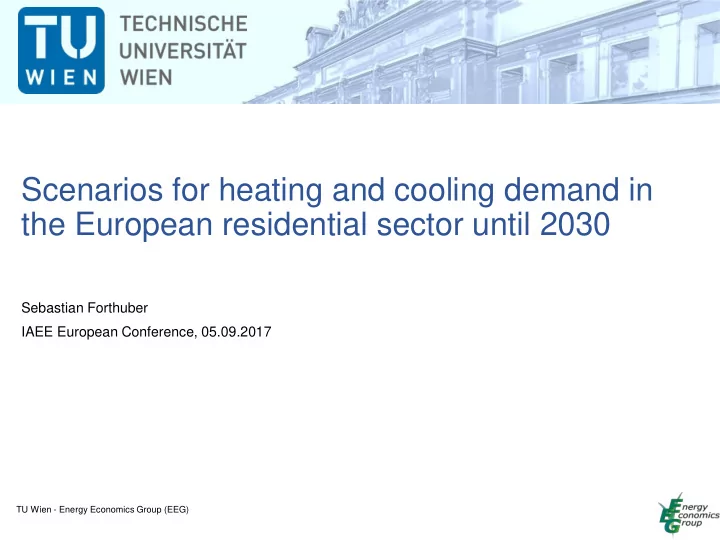

Scenarios for heating and cooling demand in the European residential sector until 2030 Sebastian Forthuber IAEE European Conference, 05.09.2017 TU Wien - Energy Economics Group (EEG)
Introduction and Contents Exemplary Model results for heating and cooling demand, focusing on total energy demand , specific heat demand , shares of end use categories (space heating, cooling, hot water), renewable shares and CO 2 -emissions Content 1. Introduction to building stock model INVERT/EE-Lab 2. Results for Heating and cooling demand in the EU28 until 2030 3. Conclusions Behavioural Response To Investment Risks In Energy Efficiency , Horizon 2020 Research Project Mapping and analyses of the current and future (2020 - 2030) heating/cooling fuel deployment (fossil/renewables), Project for the European Commission TU Wien – Energy Economics Group 2
INVERT/EE-Lab Dynamic bottom-up model that evaluates the effects of economic and regulatory conditions on total energy demand, energy carrier mix, CO 2 -emission reduction and costs. www.invert.at TU Wien – Energy Economics Group 3
Assumptions Scenario measures • Investment subsidies for building renovation, heating supply and solar thermal systems • Country specific subsidy budget restrictions • Obligations for the installation of renewable heating supply systems • Building codes : improvement of technical building standards Current policy scenario: • Decided or already implemented targets and measures for RES-H/C and energy efficiency (Renewable Energy Directive, Energy Efficiency Directive, Directive on Energy Performance of buildings, Ecodesign Directive) TU Wien – Energy Economics Group 4
Results for heating & cooling scenario in the European residential sector until 2030 (1) Final energy demand (EU28) per end use - decreases by 17% from 2012 to 2030 Cooling demand - expected to increase by 70% Final energy 2012 2020 2030 demand [TWh] Space heating 2222 1973 1710 Auxiliary energy 26 28 30 Hot water 482 489 492 Cooling 28 35 47 TOTAL 2757 2524 2279 Development of average specific energy demand: Average specific energy 2012 2030 demand [KWh/m 2 ] SFH 180 140 MFH 100 76 TU Wien – Energy Economics Group 5
Results for heating & cooling scenario in the European residential sector until 2030 (2) Final energy demand [TWh] 2012 % 2030 % ambient heat 58 2.1% 94 4.1% Final energy demand per energy carrier biomass 450 16.3% 507 22.2% coal 120 4.3% 65 2.9% Share of renewables from 19% to 31% District heating 254 9.2% 242 10.6% Electricity 279 10.1% 208 9.1% CO 2 -emissions decline by 28% fuel oil 410 14.9% 172 7.5% gas 1170 42.4% 888 39.0% solar thermal 17 0.6% 104 4.6% TOTAL 2757 2279 TU Wien – Energy Economics Group 6
Results for heating & cooling scenario in the European residential sector until 2030 (3) Heated gross floor area and specific energy needs for heating and total energy demand of building stock (existing and new buildings) for specific country Large share of building stock remains with no measures set TU Wien – Energy Economics Group 7
Further results: Intensified policy measures & greater timeframe Final energy demand for current and intensified scenario from 2012 to 2050 Intensified Measures do not show a significant impact until 2030 TU Wien – Energy Economics Group 8
Conclusions Heating demand in residential buildings decreases from 2012 to 2030, due to energy efficiency gains, and rising average temperatures Because of high inertia of heating system exchange, still high fossil share in energy carrier split (especially natural gas) in 2030 Cooling demand is increasing, but is still expected to account for a minor share of the final energy demand only, except in southern European countries Split of energy usage is expected to change moderately, as a slight shift in end use categories from space heating to cooling and water heating is expected Considerable shift in energy carrier split from fossil to renewable energy carriers, biomass stays most important renewable energy carrier Under the circumstances of a current policy scenario, the Paris climate mitigation goals are unlikely to be achieved and intensified efforts seem to be necessary TU Wien – Energy Economics Group 9
Thank you for your attention! Sebastian Forthuber forthuber@eeg.tuwien.ac.at Orig. Photo: Patrick Stargardt
References Fleiter, T., Steinbach, J., Ragwitz, M., Dengler, J., Köhler, B., Reitze, F., Tuille, F., Hartner, M., Kranzl, L., Forthuber, S., Reiter, U., 2016. Mapping and analyses of the current and future (2020 - 2030) heating/cooling fuel deployment (fossil/renewables). Project for the European Commission. Müller, A., 2015. Energy Demand Assessment for Space Conditioning and Domestic Hot Water: A Case Study for the Austrian Building Stock (PhD-Thesis). Technische Universität Wien, Wien. Kranzl, L., Müller, A., Toleikyte, A., Hummel, M., Forthuber, S., Steinbach, J., Kockat, J., 2014. Policy pathways for reducing the carbon emissions of the building stock until 2030. Report within the project ENTRANZE. Invert/EE-Lab [Model website], URL http://invert.at/ (accessed 01.09.17). B. Fries, M. Kreuzer, S. Braungardt, S. Forthuber, M. Hartner, L. Kranzl, A. Müller 2017. Deliverable 3.4 Summary Report WP3. Report within the project BRISKEE. TU Wien – Energy Economics Group 11
Appendix: CO 2 -Emissions from heating and cooling in residential building stock CO 2 -Emissions are expected to decline by 28% TU Wien – Energy Economics Group 12
Recommend
More recommend